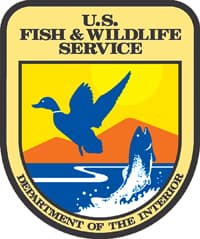Fish Habitat Partnerships and Landscape Conservation Cooperative Drive Science to Predict Changes in Aquatic Systems
OutdoorHub 06.22.12

From the Rocky Mountains to the Mid Atlantic, conservationists are joining forces to better understand variables impacting the health of fish populations and their habitats, and, to generate scientific information that can inform land-use decisions and direct conservation efforts across large landscapes.
Aquatic species from endangered mussels to native brook trout contribute to functioning ecosystems and provide fundamental economic value to local communities. Ensuring efficient and strategic management of these natural resources is key to addressing evolving stressors like agricultural land-use, invasive species, habitat fragmentation and climate change.
This landscape level view of conservation is materializing across the nation with the development of a network of Landscape Conservation Cooperatives, science-driven partnerships that cross jurisdictional and geographic boundaries in the natural resources community to combat stressors impacting our environment.
The Plains and Prairie Potholes Landscape Conservation Cooperative (LCC), established to support impactful conservation actions across the prairie pothole region, northern Great Plains and riparian corridors of the Missouri, Yellowstone and northern Red Rivers, is working in collaboration with an existing network of National Fish Habitat Partnerships (FHP), which have a successful history of leveraging federal, state, and private funding sources to achieve the greatest impact on fish populations through priority conservation projects.
This multi-partner effort has resulted in the development of advanced fish habitat assessment models using a geographic information system (GIS) to support efficient, targeted and strategic management of aquatic resources.
The Plains and Prairie Potholes LCC along with a network of 22 LCCs across the country aim to provide a platform to share information and resources such as the fish habitat assessment modeling tool that will help land-use managers and conservation managers make decisions to benefit fish and wildlife resources.
The fish habitat modeling tool will allow users to identify the habitat conditions of specific sections of streams and rivers and predict responses to anthropologic and biologic changes in those habitat conditions, which will ultimately help natural resources managers take a landscape-level approach across watersheds to management decisions and conservation actions.
West Virginia based environmental consulting firm Downstream Strategies built the decision-support tool which will be available to land managers, watershed groups and conservation-oriented communities, and will help decision makers make more effective, informed decisions about habitat restoration, fish passage and other conservation activities.
U.S. Fish and Wildlife Service (Service) fishery biologists and Fish Habitat Partnership coordinators Maureen Gallagher and Steve Krentz, are helping lead this effort in collaboration with multiple state and non-governmental agencies vested in aquatic conservation.
“What we will have is an idea of the severity of human impacts on specific segments of stream, and then we have an assumption that the severity of those impacts also tells us how degraded a particular [fish] population may be,” Gallagher said. Gallagher coordinated a training session with other Fish Habitat Partnership representatives, including field staff from the Service, The Nature Conservancy, and state natural resources agencies. The training session was held this spring at Northwest Missouri State University in Maryville, Missouri.
The training provided staff from across programs, agencies and geographic boundaries the opportunity to provide input on improving the tool’s capabilities, so that it can fulfill gaps in current scientific assessments, and help their agencies make management decisions about aquatic resources in the future.
Mark Brouder, who represents the U.S. Fish and Wildlife Service on the Great Lakes Basin Fish Habitat Partnership, attended Gallagher’s training on the GIS assessment tool, to learn how his staff can utilize the tool across the Great Lakes basin. “This tool is going to help us from a decision standpoint to better understand what stressors are on the landscape and how they are affecting aquatic habitats,” Brouder said. “We are hoping that we can then use the tool to prioritize where we look in the future to put our limited resources on the landscape, to make sure we are doing the right things in the right places.”
John Stark represents The Nature Conservancy as part of the Ohio River Basin Fish Habitat Partnership which pulls together partners from more than 50 state, federal and NGO agencies for strategic conservation and management of over 160,000 square miles of the Ohio River basin.
“If we try to work everywhere we will have a very diffuse effort. You’re not going to get focused results,” Stark said. “We need to be able to prioritize, spend the limited funds we have and direct partners to key areas.”
“There are certain aspects of restoration and rehabilitation where you have to understand what factors contribute to anthropogenic damage or habitat loss in these streams, and whether you have the authorities and tools to repair the streams,” said Paul Cunningham, fishery biologist with the Wisconsin Department of Natural Resources and representative of the Driftless Area Restoration Effort Fish Habitat Partnership.
“The Downstream Strategies modeling efforts created tools we need to help us zoom in, select, find watersheds or catchments, and help identify what we need to do to repair them,” Cunningham said.
“My opinion of landscape conservation is looking at a conservation of our natural resources from a larger viewpoint, larger than a tribe, state or single source issue,” Krentz said. “We are seeing folks working together on aquatic and terrestrial issues and making linkages across habitats that have systematic effects on populations.”
For an interactive demonstration of the aquatic habitat assessment decision support tool visit www.midwestfishhabitats.org

